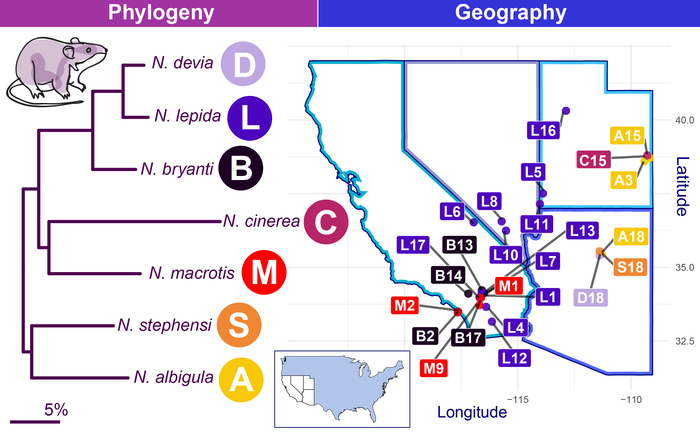Every mammal hosts a hidden community of other organisms—the microbiome. Their intestines teem with complex microbial populations that are critical for nutrition, fighting disease and degrading harmful toxins. Throughout their lives, mammals are exposed to countless microbes through their food and environment, but only a small subset take up permanent residence in the host. Although scientists agree that diet, geography and evolutionary history structure the microbiome, the relative influence of each factor is a mystery. No rigorous study has investigated all three at once in wild mammal populations. Until now.

Credit: Adapted from Weinstein et.al. (2021) PNAS
Every mammal hosts a hidden community of other organisms—the microbiome. Their intestines teem with complex microbial populations that are critical for nutrition, fighting disease and degrading harmful toxins. Throughout their lives, mammals are exposed to countless microbes through their food and environment, but only a small subset take up permanent residence in the host. Although scientists agree that diet, geography and evolutionary history structure the microbiome, the relative influence of each factor is a mystery. No rigorous study has investigated all three at once in wild mammal populations. Until now.
A team of University of Utah biologists analyzed the bacteria in the gut microbiome of woodrats (Neotoma species), a group of closely related herbivorous rodents abundant in the southwestern United States. The animals offered a unique opportunity to test how diet, geography and evolutionary history influence microbiome structure. The many woodrat species are morphologically similar, but populations live in a variety of habitats and have distinct diets. Woodrats are famous for eating extremely toxic plants and do so with support from specialized gut bacteria.
“Woodrats are amazing—they have incredibly diverse diets. Individuals from the same species eat different foods at different locations, so it creates a natural experiment,” said lead author Sara Weinstein, postdoctoral research associate at the U. “It’s hard to say what’s driving their different microbiomes—is it what they’re eating? Is it where they’re living? Or is it who they are?”
The researchers used DNA barcoding techniques to characterize the diet and gut bacteria of seven woodrat species from 25 populations at 19 locations across the southwestern U.S. The biologists then brought the rodents into captivity, fed them a diet of rabbit chow for one month and then resampled their microbiome. The results show that in both wild and captive individuals, evolutionary history was the biggest predictor of microbiome structure — more than diet and geography.
“There is keen interest in quantifying the relative contributions of the factors that govern the microbiomes of animals in nature. Our research—a real team effort—addressed a gap in our knowledge by simultaneously interrogating three key factors thought to influence gut microbial communities of wild animals” said senior author Denise Dearing, distinguished professor of biology at the U. “Given the varied, toxic diets ingested by woodrats, I thought diet was going to have the largest impact. Instead, we learned that evolutionary history plays the greatest role in structuring the gut microbial communities of woodrats. It’s unexpected results like this that underscore the importance of conducting scientific research.”
The study was published in the journal, Proceedings of the National Academy of Sciences, on November 15, 2021.
Woodrats aren’t just what they eat
In wild populations, diet and geography did influence microbiome composition and diversity.
Diet contributed to natural microbiome structure. The authors collected feces from each rodent at the time of capture to get a snapshot of their diet. Using these samples, they found that animals with more diverse diets had more diverse microbiomes, and animals that fed on similar plants also showed similarities in their microbial communities.
Geography also played a role. The authors found that individuals at the same site had more similar microbiomes, and these communities became more dissimilar as animals were sampled at more distant locations.
However, host relatedness was still the most important factor predicting the microbial makeup of these wild mammals. And these effects only increased when animals were in captivity.
The authors brought animals into captivity to reduce their exposure to different microbes from their diet and environment. They predicted that, if the effects of diet and local site primarily determined microbiome composition, woodrat microbiomes would converge in captivity. Alternatively, if differences were primarily due to host genetics, woodrat species would retain distinct microbiomes.
“While every individual experienced a large shift, each individual’s microbiome was still closer to its wild self than it would be to any other woodrat species,” said Weinstein. “We didn’t see microbiomes merging into the same makeup; species retained distinct bacterial communities. With the differences of diet and habitat removed, you see even more clearly the extent to which host relatedness influences microbiome structure.”
The research team also found that microbiome responses to captivity were species specific, suggesting that host evolutionary history influences not only microbiome structure, but also stability.
Other co-authors of the study are Tess E. Stapleton, Dylan M. Klure, Robert Greenhalgh and Colin Dale of the School of Biological Sciences at the University of Utah; Rodolfo Martínez-Mota of the U and Centro de Investigaciones Tropicales at the Universidad Veracruzana; Teri J. Orr of the Department of Biology at New Mexico State University; and Kevin D. Kohl of the Department of Biological Sciences at the University of Pittsburgh.
Funding was provided by NSF Dimensions DEB 1342615, NSF IOS 1656497; Ruth L. Kirschstein National Research Service Award NIH T32AI055434; Genetics Training Grant NIH 5T32GM007464-38; and a Smithsonian-Mpala fellowship.
Journal
Proceedings of the National Academy of Sciences
Method of Research
Experimental study
Subject of Research
Animals
Article Title
Microbiome stability and structure is governed by host phylogeny over diet and geography in woodrats (Neotoma spp.)
Article Publication Date
15-Nov-2021




